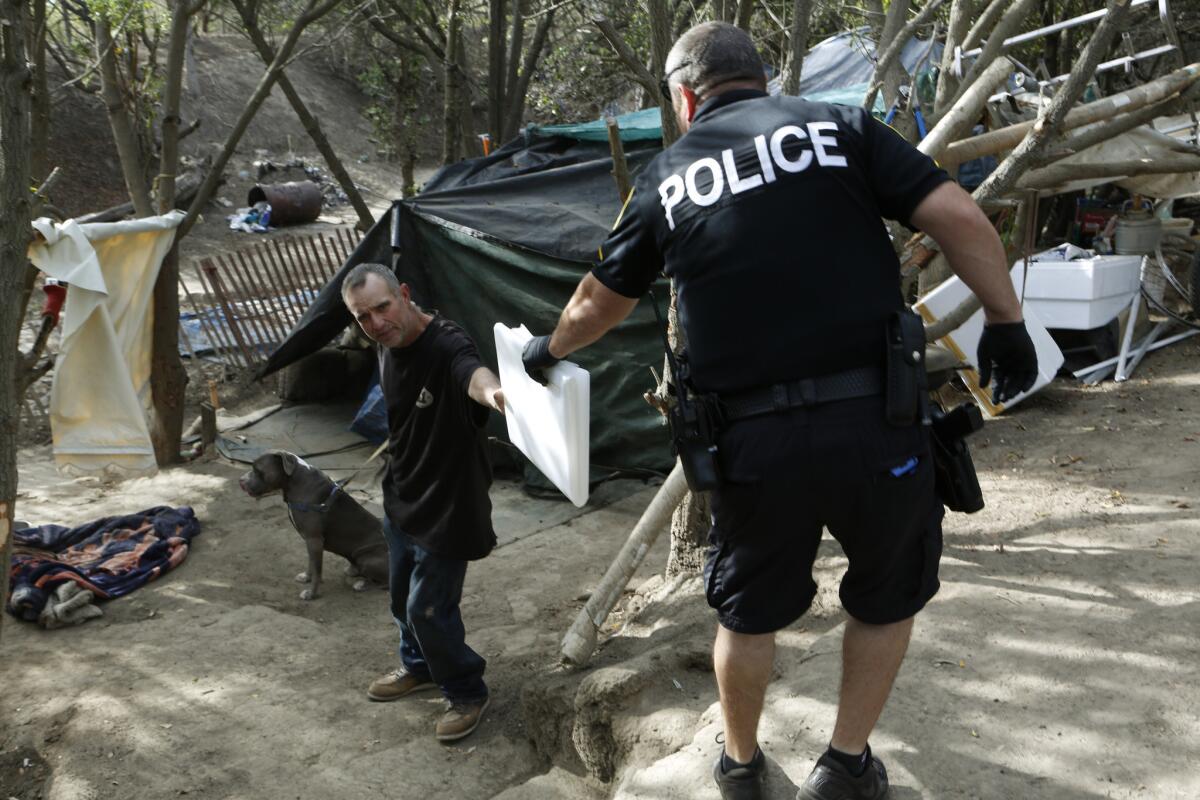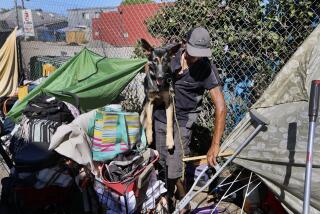For decades-old homeless camp, the end is near

Oxnard police Officer Jake Jundef hands plastic bags to a homeless man named Cuba for packing personal items in advance of the encampment being cleaned out.
Behind thick brush on the banks of a canal in Oxnard, almost invisible from the road, about 18 homeless men and women pieced together a village long ago.
Carrie Sadler, 53, lived in a house fashioned from plywood boards, blue and black plastic tarps with white window trimmings and a roof. Stairs carved out of the earth lead to it, and nearby, others have created homes with power generators that are decorated with personal touches such as potted plants.
Dogs bark loudly in the camp, which is littered with trash and empty liquor bottles.
“In less than two years I lost everything I worked for,” said Sadler, who said she became homeless about two years ago after her boyfriend died from cancer. Before arriving at the camp about six months ago, she lived out of a 1994 Jaguar, behind a Jack in the Box for a while.
There are even a few who have called the homeless camp home for as long as three decades.
But that will end Tuesday when volunteers, sanitation workers and bulldozers descend on the land, leased by a local energy provider, and clear it out. The razing of the Oxnard camp is unlikely to get the attention of the demolition last year of a camp in San Jose called “The Jungle.” That 68-acre shantytown had become a powerful symbol of Silicon Valley’s homeless problem amid skyrocketing, tech-fueled wealth.
San Jose and the surrounding Santa Clara County had an estimated 7,600 homeless people in 2013. Far less populated, Ventura County had more than 1,400 homeless people last year, according to the county, with more than half living either in the city of Ventura or Oxnard. But although those numbers represent a 26% reduction countywide since 2007, the number of homeless people in Oxnard has roughly remained the same.
Last fall, Oxnard borrowed Community Services Manager Peter Brown from neighboring Ventura, where for 16 years he coordinated that city’s successful effort to reduce the homeless population. Oxnard decided to cover half of Brown’s salary and benefits, which add up to $155,000 a year.
Eliminating the camp just off Harbor Boulevard became a top mission for Brown. To do his job he became familiar with those living in the homeless camp who he’s tasked to get rid of.
He described himself as a man at the center of the box with sometimes conflicting constituencies to answer to at every corner: law enforcement, residents unhappy with the homeless, advocates who provide social services and the homeless themselves.
“I live in the middle of that box,” said Brown. “I’m a connector constantly trying to get these sometimes competing interests to work together.”
On a Thursday morning in early August, social workers and volunteers from such groups as the Salvation Army and the Ventura County Rescue Mission, along with two cops, stood outside the camp’s entrance, waiting for Brown to arrive. They have been accompanying him on trips here since February. With Brown’s arrival, the group walked into the camp.
Social workers each are assigned to a resident of the camp, and it’s their task — not Brown’s — to figure out how to get these folks on Social Security or veterans benefits or whatever might be out there for them. With them, wearing a medical mask over his mouth as he fights a cold, is Oxnard Police Officer Jake Jundef, the city’s lone homeless liaison officer — or as he’s sometimes called, “the homeless cop.”
Though an outsider may not see these camps as real neighborhoods with homes, it’s difficult for people who live in them to leave for a variety of reasons, said Nan Roman, president and CEO of the National Alliance to End Homelessness. People who live in such camps can become dependent on one another, for good and for bad.
“Once you invest in the infrastructure of your home and area, it’s hard to leave it,” Roman said.
Maria DuPre, 53, has been at the homeless camp since last fall, and cares for a sick husband, a military veteran who is in a hospital. She’s close to finishing the installation of an engine on a beat-up white sedan after a mechanic gave her the parts. Soon, she and her husband can hit the road in search of another place to call home.
But DuPre said she refuses to leave. She doesn’t like everyone she shares the camp with, but she wants to stay.
“I just want everyone else to go. But we’re not leaving,” DuPre said.
Brown knows the residents by name. He and Jundef have a list to keep track of who would be eligible for short-term housing once the camp is gone. Jundef has been trying to help Sadler, who lost most of her belongings when an SUV she traded her Jaguar for was towed. It had expired tags.
“Everything I own is in that damn truck,” Sadler said.
Brown, whose sometimes gruff, straight-ahead demeanor can rub some of the homeless men and women, and even many of the social workers, raw, asks Sadler: “What’s your plan?”
With her golden retriever, she wants to return to Washington state, to her two sons and six grandchildren. Jundef promises to help her retrofit another truck so that it can drive. Amanda Herrera, social services supervisor for the Society of St. Vincent De Paul, mulls how to get Sadler gas credit for her journey north.
“As soon as they can get me out of here,” said Sadler. “There’s not much for me here anymore.”
But other homeless people have no solid plans for after the bulldozers roll in. While Sadler said Brown has been good to her, she also said other homeless neighbors have told her, “He’s the enemy.”
“I guess it’s scary whenever change comes,” she said.
Brown said every resident will get at least three days in a hotel or motel — “depending on how they comport themselves.” Some may be able to find more long-term housing using federal Section 8 vouchers.
Brown knows he’s far from well-liked by everyone in his proverbial “box.” He’s not bothered by it. “Perfection is the enemy of good,” he likes to repeat. As he walks from the camp, he proudly shows an email he got from the Oxnard resident who originally reported the homeless camp that’s about to go down.
The man, who said his home had been burglarized by people from the camp, told Brown he was happy to see change coming.
Ticketed and towed: Owner of minivan hopes his court victory inspires others
LAPD broke labor laws in requiring some officers to repay training costs, court rules
Yosemite National Park campground to be closed while officials try to wipe out plague
More to Read
Sign up for Essential California
The most important California stories and recommendations in your inbox every morning.
You may occasionally receive promotional content from the Los Angeles Times.











